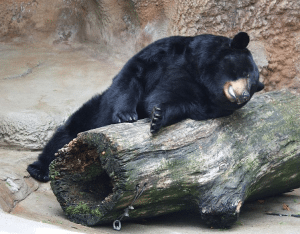Coyotes and Lions and Bears…In Virginia?
 We had a visit from a friend from across the country. She has actually been living half way across the world in Alaska. We took a stroll around downtown Richmond, and she found it shocking that we didn’t have lids on the trashcans. What did we need lids for? To keep the trash in the cans?
We had a visit from a friend from across the country. She has actually been living half way across the world in Alaska. We took a stroll around downtown Richmond, and she found it shocking that we didn’t have lids on the trashcans. What did we need lids for? To keep the trash in the cans?
“No. To keep the bears out.”
We thought that was pretty ridiculous. And then we heard about a black bear being sighted on the outskirts of Richmond, just a few miles from where we had been walking.
Sounds incredible, doesn’t it? A mature, 300 pound black bear, walking around the suburbs. Maybe he was looking for a frozen yogurt or planning on grabbing a Starbucks. But it really shouldn’t be that big of a stretch to think that our more urban areas are the home to some large animals. Virginia was once roamed by many mighty beasts, and some are making quite the comeback.
In Virginia’s Capital city we have seen a resurgence of many large animals. From the offices in downtown Richmond you can routinely see bald eagles, large turkey vultures, and for a time a breeding pair of peregrine falcons. Many of the older homes in the historic neighborhoods have hosted red tailed and red shouldered hawks, and ospreys haunt the tidal areas of the lower James River.
The James River has also seen the return of a behemoth from deeper waters. Scientists from Virginia Commonwealth University have spotted Atlantic sturgeon in the shallows just minutes from the Federal Courthouse. While anglers have pulled some pretty big catfish and bass from the James, these beasts can grow up to 10 feet long, and the fact that they’re once again returning to the James to spawn speaks highly of our efforts to clean up the river.
And our expansion of green spaces and ecological efforts have helped other species as well. During Thomas Jefferson’s time, Virginia boasted of elk, bison, wolves, cougars, and many other large mammals. As our population grew and our Commonwealth became more urban, habitat for these animals became more and more scarce. By the 1930’s, we had culled or chased out most of our elk and bison, and across the country we were down to about 300,000 deer. The United States currently has about 30 million white tailed deer, and it often seems like many of those live here in Virginia!
 Part of the reason for the rebound of deer in Virginia is the fact that we are about its only predator. It’s been a while since anyone saw a wolf in Virginia, and a healthy deer is a little large for a bobcat to take down. And yes, we do have bobcats. Every few years you’ll hear something anecdotal about a cougar (or puma), but these are probably not Virginia natives. There are big cats out west, and a small population in the swamps of Florida, but any true mountain lion in Virginia is probably a transplant. Some researchers say that sightings in Virginia are most likely an animal that was being kept as a pet and ended up getting out. Kind of like the boas and pythons that are currently eating everything in the Everglades.
Part of the reason for the rebound of deer in Virginia is the fact that we are about its only predator. It’s been a while since anyone saw a wolf in Virginia, and a healthy deer is a little large for a bobcat to take down. And yes, we do have bobcats. Every few years you’ll hear something anecdotal about a cougar (or puma), but these are probably not Virginia natives. There are big cats out west, and a small population in the swamps of Florida, but any true mountain lion in Virginia is probably a transplant. Some researchers say that sightings in Virginia are most likely an animal that was being kept as a pet and ended up getting out. Kind of like the boas and pythons that are currently eating everything in the Everglades.
One animal that is sneaking back in with some frequency is the coyote. We think of coyotes as lonesome animals howling at the moon the American Southwest, but they are really quite at home here in Virginia, and often get quite comfortable in our suburbs and cities. A study from Ohio State University estimates that there may be as many as 2,000 of them living in downtown Chicago, so it shouldn’t come as a surprise that they’re joining our community here. Perhaps more interesting is the fact that studies of their DNA show that the coyotes have been mating with wolves, creating a sort of “super-coyote” that is better suited to expansion into newer territories. They seem to have gotten particularly comfortable in New England, and then followed the Appalachian Mountains south, setting up a thriving community in Northern Virginia.
So it may be a while before we see bison freely roaming the Shenandoah countryside (although there are a few domestic herds in Virginia). And we may not soon hear the bugle call of a bull elk (although a small herd of western elk was released this past spring near Grundy). But some of our larger critters are seemingly here to stay. And this is a good thing. Making our state friendlier to wildlife is an important step towards our goal to Keep Virginia Beautiful.
